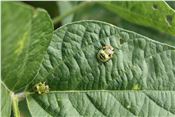Stink Bugs And Soybean Aphids In Late Soybean
DR. SCOTT STEWART
JACKSON, TENN.
Soybean Aphids are occurring in some very late soybean fields in the northwest corner of West Tennessee. I’ve had several reports from Dyer and Lake Counties. This is the first time we’ve seen significant soybean aphid numbers in this part of the state. In some years, we’ve seen treatment levels in Middle Tennessee. This invasive pest drifts down from the north and doesn’t appear to like our southern climate. When we do see it, it tends to occur beginning late August through September as the temperatures cool.
In the Midwest, where this is a common pest, the suggested threshold is to treat when an average of 250 aphids or more are found per plant from early bloom (R1) until early pod fill (R5). Treatment after R5 is less likely to increase yield. Thus, you might consider treating very late soybeans that reach this threshold. It’s not an easy decision on these very late fields planted after the flooding because yield potential is questionable. The good news is that this aphid is easy to control with synthetic pyrethroids and some other relatively cheap products. A list of recommended insecticides can be found here.
Stink bugs numbers, as usual, are picking up rapidly as later fields begin approaching R6 (full seed). Also as usual, the population is composed mostly of green stink bugs and primarily immatures (nymphs). Treatment is suggested up to R6 when numbers reach or exceed an average of 9 bugs/25 sweeps. Beginning at R6 and continuing for 7-10 days, treat when an average of 18 or more stink bugs is found per 25 sweeps. You might consider hiring an airplane to avoid tire track damage to the crop. Research indicates you can cause 1-3 bushel yield loss by driving over soybeans at R6 or later, particularly on narrow rows (as most of ours are). ∆
DR. SCOTT STEWART: IPM Extension Specialist, University of Tennessee

Soybean aphids

Immature green stink bugs